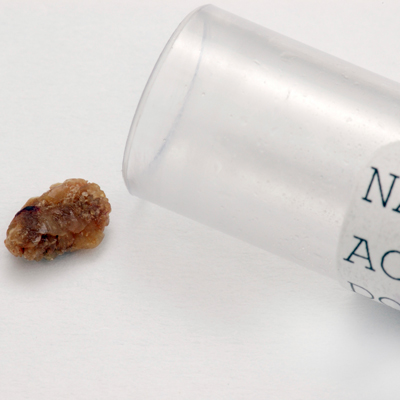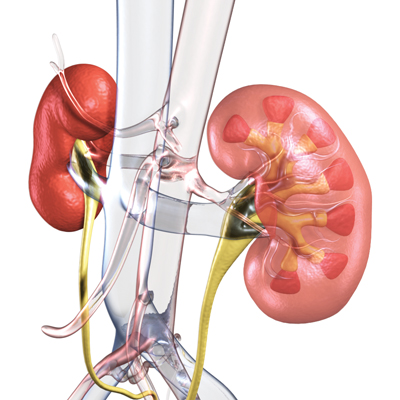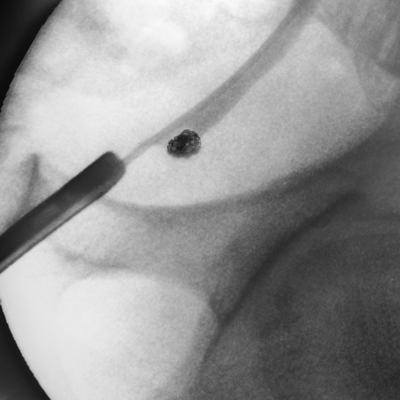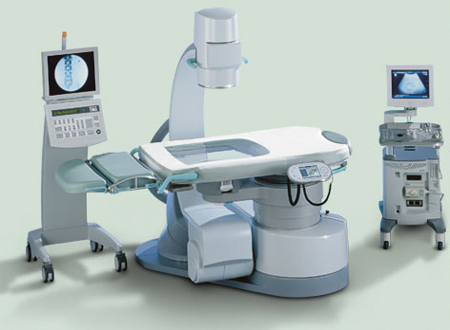What are Kidney Stones?

The job of your kidneys is to filter blood and create urine. Kidney stones usually form when your urine is too concentrated with certain minerals or other substances. These substances normally pass in your urine, but they can become highly concentrated and crystalize when there is not enough urine volume. Typically, this is a result of not drinking enough fluids.
Kidney stones usually range in size from as small as a grain of sand or gravel to the size of a chickpea. They can even be as large as golf balls. Smaller stones (those less than the size of a chickpea) can pass through the urinary tract on their own but may be associated with significant pain. You may or may not notice these stones, depending on their size. Larger stones can get trapped in the ureters (the tubes that drain urine from the kidney into the bladder). When this happens, the stones keep urine from exiting that kidney. Blocking the flow of urine can be imaged as a dam blocking a river, and it causes severe pain or bleeding. Stones that can’t pass on their own are treated with surgery. The decision to undergo surgery is based on the stone size, number of stones, location, and other factors such as shape, type, and the patient’s preference. If a blocking kidney stone is not treated, it can affect the kidney’s function and ability to filter.
Causes

Many conditions or diseases may contribute to the formation of kidney stones; for example:
- A chemical abnormality of the blood or urine. Normal urine contains chemicals that prevent these crystals from forming, but more than 90 percent of people with kidney stones have a chemical abnormality that contributes to the tendency to form stones.
- Chronic dehydration. Not drinking enough water may contribute to the formation of stones. Inadequate fluid intake causes the kidneys to produce less urine, as well as urine that is highly concentrated. The smaller the daily volume of urine, the more likely it is that a kidney stone will develop. If you live in a hot, dry climate where dehydration is a constant concern, or you do not drink water for long periods during the day, you are also at increased risk of kidney stone formation.
- A family history of kidney stones. A family member with kidney stones means you may be more susceptible to also developing kidney stones.
- A previous kidney stone. About half of people who have had a kidney stone will develop another within 10 years.
- A diet high in sodium, protein, and foods that increase acid levels may contribute to stone formation.
- Obesity.
- A history of certain medical conditions, which cause you to have higher or lower levels of the substances that make up a kidney stone. These conditions can include:
- Hypercalciuria (high calcium levels in the urine).
- High blood pressure.
- Diabetes.
- Obesity.
- Gout.
- Kidney cysts.
- Cystic fibrosis.
- Parathyroid disease.
- Inflammatory bowel disease.
- Chronic diarrhea.
- Some surgical procedures, including weight loss surgery or other stomach/intestine surgeries, such as inflammatory bowel disease or gastric bypass surgery.
Certain medications can increase your risk of developing a stone. These include:
- Calcium-based antacids or calcium supplements.
- Crixivan® (used to treat HIV infections).
- Topamax® and Dilantin® (used to treat seizures).
- Cipro® (ciprofloxacine).
- Ceftriaxone (antibiotics).
- Vitamin C supplements.
Certain foods can also place you at risk of a kidney stone. These foods include:
- Meats and poultry (foods high in animal proteins).
- Sodium (diets high in salt, most often from processed foods.
- Sugars (fructose, sucrose, and corn syrup).
Symptoms

What are the Signs and Symptoms of Kidney Stones?
You can actually have a kidney stone in your kidney for years and not know it’s there. When it starts to move, however, or becomes very large, you may start to feel symptoms. These may include:
- Feeling pain in the lower back or side of the body. This pain can start as a dull ache that may come and go. It can become severe and result in a trip to the emergency room. Sometimes it can be hard to determine if the pain is from a kidney stone or a muscle pain.
- Having nausea or vomiting along with the pain
- Seeing blood in your urine.
- Feeling pain when urinating.
- Being unable to urinate.
- Feeling the need to urinate more often.
- Experiencing fever or chills.
Keep in mind, however, that some kidney stones are “silent,” and do not cause any symptoms at all
Diagnosis
Diagnosis
If you have symptoms of kidney stones, your doctor will start with a physical exam and review of your medical history. Other tests include:
- Imaging tests to see the size, shape and location of the stones. These tests determine the most suitable treatment and sometimes are used to review the results of your treatment. Types of imaging tests used are X-rays, CT scan and ultrasound. Both X-ray tests and CT scans use a small amount of radiation to create their images.
- Blood test to measure how well your kidneys are functioning, to look for signs of infection, and to look for biochemical problems that lead to forming kidney stones.
- Urine sample test to look for signs of an infection.
- A 24-hour urine test to examine the levels of the stone-forming substances—calcium, oxalate, urate, cystine, xanthine, and phosphate.
A CT scan of the abdomen is an imaging test that creates a three-dimensional view of the organs within the abdominal cavity. Typically, no contrast (or dye) is used for kidney stone diagnosis. This test shows the stone size and location and conditions that may have caused the stone to form. In addition, the other organs within this area of the body can be evaluated.
An ultrasound of the urinary tract uses sound waves to detect kidney stones and indirect signs of kidney stones, such as changes in the kidney’s size and shape
Treatments

Management and Treatment
How are Kidney Stones Treated?
Your treatment options for a kidney stone can vary depending on the size of the stone and where it is located in your urinary tract. Treatment options include:
- No treatment. Small stones may not need treatment if they can pass out of the body on their own or if they are not causing a blockage.
- Medications. To relax the ureter to allow stones to pass.
- Minimally invasive procedures. Procedures carried out by entering the body through a small incision in the skin or through the body’s natural openings (the urethra)
No treatment. Sometimes kidney stones can pass through urine on their own depending on the size and location. Drinking plenty of liquids helps the kidney stones travel through the urinary tract. Passing the stone may take up to four weeks.
Medications. Severe pain, requiring an emergency room visit, can be managed with IV narcotics, anti-inflammatory drugs, and drugs to reduce nausea/vomiting. Stones causing less pain can be managed with an anti-inflammatory drug such as ibuprofen. (Caution: Ask your doctor before taking ibuprofen. This drug can increase the risk of kidney failure if taken while having an acute attack of kidney stones, especially in those who have a history of kidney disease and associated illnesses such as diabetes, hypertension and obesity. Other medications may be given to relax the ureter such as tamsulosin (Flomax®) or nifedipine (Adamant®, Procardia®) so that the stones can pass on their own.
Procedures
Three types of minimally invasive surgery are available for stone removal– ureteroscopy, shockwave lithotripsy and percutaneous nephrolithotomy. The type of surgery that is selected is based on a patient’s body and stone characteristics, medical conditions and preferences.
- Ureteroscopy. To perform this procedure, a small camera, called an ureteroscope, is inserted in the urethra, through the bladder, and into the ureter. This instrument allows stones to be seen and then retrieved in a small surgical “basket” or broken apart using a laser. These smaller pieces of kidney stones are more easily able to exit the body through the urinary tract. A urethral stent is often placed after the procedure (an internal tube from the kidney to the bladder which is removed one – two weeks after surgery in the office).
- Shockwave lithotripsy. In this procedure, high-energy shock waves are sent through water to the stone(s)’ location. The shock waves break apart the stones, which are then more easily able to exit the body through the urinary tract. A urethral stent may be placed.
- Percutaneous nephrolithotomy. When kidney stones can’t be treated by the other procedures—either because there are too many stones, the stones are too large or hard, or because of their location—percutaneous nephrolithotomy (PCNL) is considered. In this procedure, a tube is inserted directly into the kidney through a small incision made in your back. Stones are then disintegrated by an ultrasound probe and extracted via a special suction reducing the chance that you will have to pass any fragments. A urethral stent is placed after the procedure and is removed in the office one to two weeks after surgery. Patients are typically kept overnight for observation and discharged in the morning.
- Open or robotic- assisted stone surgery. Open stone surgery is rarely performed. Only 0.3% to 0.7% of cases require this procedure.
How long does it take to pass a kidney stone?
The amount of time it can take to pass a kidney stone varies. A stone that’s smaller than 4 mm may pass within one to two weeks. A stone that’s larger than 4 mm could take about two to four weeks to completely pass.
Prevention
How Can Kidney Stones be Prevented?
There are several ways to decrease your risk of kidney stones, including:
- Drinking more fluids, especially water. You should drink at least 64 ounces of liquids per day. In some cases, 2 to 3 liters of liquids per day. Liquids help you stay hydrated. Staying hydrated helps you urinate more often, which helps “flush away” the buildup of the substances that cause kidney stones. If you sweat a lot from your activities, be sure to drink more water.
- Limiting the amount of salt (sodium) in your diet — the DASH diet is a low-sodium option.
- Losing weight if you are overweight.
- Managing diabetes.
- Limiting the types of foods and drinks that led to the development of your specific type of kidney stone. You may be asked to collect your urine over a 24-hour period. Stone fragments and minerals in the urine can help identify what may have caused your kidney stone. Based on the stone’s content, a dietitian may suggest changes in your diet to help decrease your risk of developing more stones.
- Taking medication prescribed by your doctor to help prevent kidney stones based on your specific stone type and any health problems that make you more likely to form a stone.
Should I Cut Calcium out of My Diet if I Develop Calcium Oxalate Kidney Stones?
If you develop kidney stones composed of calcium, you may be tempted to cut calcium out of your diet. However, this is actually the opposite of what you should do. If you have calcium oxalate stones, the most common type, it’s recommended that you have a diet higher in calcium and lower in oxalate. Foods that are high in oxalates include:
- Spinach.
- Rhubarb.
- Strawberries.
- Tea.
- Dried peas and beans.
- Nuts and nut butters.
- Wheat bran.
Foods that are high in calcium include:
- Cow’s milk.
- Yogurt.
- Cheese.
- Broccoli.
- Kale.
- Calcium-fortified juices.
- Dried beans.
- Salmon.
- Calcium-fortified hot cereal.
Talk to your healthcare provider about the best foods and drinks to prevent the development of future stones. Often there will be certain foods that work for you but not for another person.
Should I Drink Soda and Coffee If I Have Kidney Stones?
There are some beverages that aren’t recommended if you have kidney stones, including soda. Sweetened and dark colas are linked to an increased risk of stone formation. You should also avoid drinks with sugar or corn fructose syrup.
Coffee, however, has been linked to a decreased risk of developing kidney stones. Studies have shown that people who drink coffee have fewer kidney stones.
Outlook / Prognosis
What Is the Outlook for Kidney Stones?
The outlook for kidney stones is very positive, although there is a risk of recurrence (the stones coming back). Many kidney stones pass on their own over time without needing treatment from your healthcare provider. Medications and surgical treatments to remove larger kidney stones are generally very successful and involve little recovery time. It is possible to get kidney stones multiple times throughout your life. If you find you keep developing kidney stones, your healthcare provider may work with you to discover why the stones happen. Once the cause is found, you may be able to make lifestyle changes to prevent future stones from forming.
Can a Large Kidney Stone Cause an Injury?
Your risk of injury from a kidney stone can go up based on the size and location of the stone. The size of the stone is important as it passes out of your body. A larger stone could get stuck in your ureter, causing pressure to build up in the kidney. This can lead to renal failure and, in the worst case (but rare) scenario, you could lose your kidney. The chance of passing a 1 cm stone is less than 10%, and stones larger than 1 cm typically do not pass.
How Long Does Pain Last After You Pass a Kidney Stone?
Pain from a kidney stone can persist for a few days after completely passing a stone, and this can vary. If the pain persists beyond a week after passing a stone, your caregiver may order an ultrasound to see if any further blockage is present (sometimes due to a remaining stone fragment or from a muscle spasm in the ureter).
The Kidney Stone Clinic
If you are at risk of kidney stone recurrence, you may be followed in Cleveland Clinic’s Kidney Stone Clinic. Our nephrologists and urologists investigate the cause of kidney stone formation through 24-hour urine analysis, blood tests, and metabolic laboratory tests. Clinic staff will then develop and tailor comprehensive prevention strategies specifically for you. You will benefit from a better understanding of why stones develop and what changes you can make in your everyday life to prevent them.
Personalized diets
Increasing your fluid intake is always recommended, but other dietary interventions are not necessarily the same from patient to patient. In the Kidney Stone Clinic, you will receive a personalized diet based on the results of your stone panel analysis. A certified nurse practitioner trained in stone-related dietary counseling works with you and your physician to develop a tailored intervention plan. This plan will also address any other health-related issues you may have. You will also receive guidance on reading food labels and other useful information at these visits.
Convenient access
Simple dietary changes can have a dramatic impact on preventing future stone formation. All patients currently forming stones are encouraged to actively engage in dietary counseling. If it is more convenient, you may follow up with a registered dietitian at a Cleveland Clinic family health center in your community. Consult your insurance plan to determine coverage for dietitian services.
Patient Services
Medical Concierge
If you are traveling from out of state and need any assistance, call the complimentary Medical Concierge at 800.223.2273, ext. 55580, or email medicalconcierge@ccf.org
Global Patient Services
Complimentary assistance for national and international patients and families is available at 001.216.444.8184, or visit clevelandclinic.org/gps.
MyChart
Cleveland Clinic MyChart® is a secure, online personal healthcare management tool that connects patients to portions of their medical record at any time, day or night. Patients can view test results, renew prescriptions, review past appointments and request new ones. Our latest feature, Schedule My Appointment, allows patients to view their primary care physician’s open schedule and make appointments online in real time. Patients register for MyChart through their physician’s office or online.
Appointments
To make an appointment with a kidney stone specialist in the Glickman Urological & Kidney Institute, call 216.444.5600 or 888.223.2273, ext. 45600.
For Cleveland Clinic in Florida, call 877.463.2010.
Why Choose Us?
Choosing Care for Your Kidney Stones
While many centers offer kidney stone treatment, it’s important to consider the experience of this particular program. Nephrologists and urologists in Cleveland Clinic’s Glickman Urological & Kidney Institute explore all medical, surgical and dietary options in kidney stone treatment to ensure the best outcome for every patient. The goals of our multidisciplinary, comprehensive program are not only to treat any current kidney stones you may have, but also to prevent future stone formation.